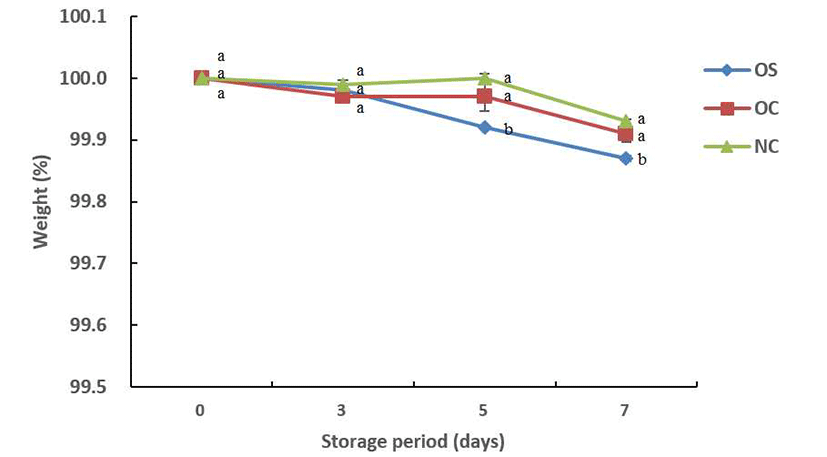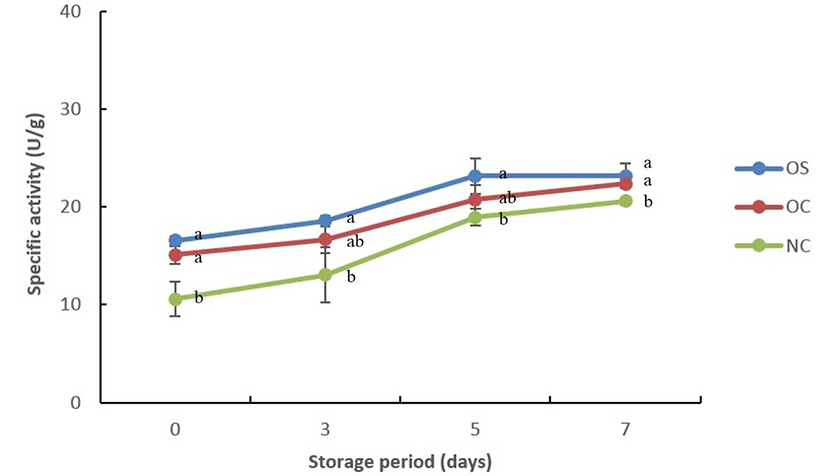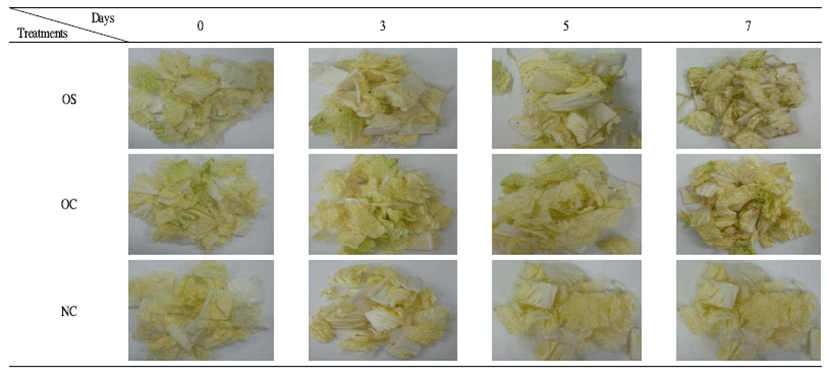ARTICLE
절단배추의 선도유지를 위한 절단 공정 개선
성기운1, 정헌식2, 정신교1,*
The cutting process improvement for cut kimchi cabbage quality
Gi-Un Seong1, Hun-Sik Chung2, Shin-Kyo Chung1,*
1Department of Food Science and Technology, Kyungpook National University, Daegu 702-701, Korea
2Department of Food Science and Technology, Pusan National University, Miryang 627-706, Korea
*Corresponding author.
kchung@knu.ac.kr Phone:82-53-950-5778, Fax : 82-53-950-6772
© The Korean Society of Food Preservation. This is an Open-Access article distributed under the terms of the Creative Commons Attribution Non-Commercial License (http://creativecommons.org/licenses/by-nc/3.0/) which permits unrestricted non-commercial use, distribution, and reproduction in any medium, provided the original work is properly cited.
Received: Nov 5, 2014; Revised: Dec 15, 2014; Accepted: Dec 22, 2014
Abstract
To maintain the freshness and to prevent browning of cut Kimchi cabbages, the effect of the cutting process using a ceramic knife under N2 blowing on the quality of the cut Kimchi cabbages was investigated. Kimchi cabbages cut with a ceramic knife under N2 gas blowing conditions (NC) were stored at 5°C for 7 days, and their weight reduction ratio and the browning degree and appearance were compared with those of the control treatment samples (OS; cut with a stainless steel knife under normal air, OC; cut with a ceramic knife under normal air). The weight reduction ratios were 0.07~0.13%, and the NC treatment showed the lowest reduction ratio among all the treatments (p<0.05). The Hunter L values increased, but the a and b values decreased after 5-day storage in all the treatments. The NC treatment had higher L values but lower a and b values than the OS and OC treatments. The browning degrees by Hunter color value, PPO activity, and appearances were the least in the NC treatment (p<0.05). The cutting process with a ceramic knife under N2 blowing could be applied to the cutting of vegetable products and for minimal fruit processing.
Keywords: cut kimchi cabbage; browning; N2 blowing; ceramic knife
서 론
최근 농산물의 소비추세는 간편성과 합리성을 추구하면 서 구입 한 뒤 박피, 절단, 세척 등과 같이 가공처리를 최소 화하여 바로 먹을 수 있는 형태나 조리에 사용할 수 있는 있는 신선편이 농산물의 수요가 증가하고 있으며, 건강 지 향 문화가 확산되면서 신선편이 채소류에 대한 소비도 늘어 나고 있다(1,2). 이에 따라 단체급식, 외식업체 및 가정 등에 서 음식을 조리 하는데 사용될 수 있도록 준비된 당근, 양배 추, 상추, 피망 등의 절단 야채(cut vegetable, shredded vegetable)와 사과, 배 등의 최소가공제품이 유통 되고 있는 상황이다(3). 배추(Brassica rapa L. ssp. pekinensis)는 식이 섬유, 각종 비타민 성분과 칼슘을 비롯한 무기질 성분이 풍부하여 김치 외에도 다양한 요리의 주재료 및 부재료로 사용되고 있다(4,5). 최근 배추의 생산량의 증가와 함께 신 선편이 제품화를 위하여 겉절이나 공장 보급용으로 절단된 형태로 유통되는 방안이 연구 되고 있다(6,7). 채소류의 절 단은 호흡속도를 증가시키고 절단면의 산화적, 비산화적 갈변을 유발하여 급격한 품질저하를 초래하게 된다. 신선 편이용 채소류의 선도유지 저장과 갈변방지를 위하여 절단 도구와 절단 크기를 조절(8)하거나, 세척 방법 개선(9), 예냉 (10), 데치기(11) 및 갈변저해제(12) 사용에 의한 연구들이 있으며 절단배추의 선도유지 방안으로 Ca2+ 처리(13)와 예 열처리(14)가 보고된 바 있다.
본 연구에서는 절단배추의 품질 향상을 위하여 질소 치 환과 세라믹 칼날을 사용하여 절단 공정을 개선하고 그 효과를 조사하였다.
재료 및 방법
재 료
배추(Brassica rapa L. ssp. pekinensis)는 경상북도 영양군 에서 2013년 7월 하순경에 수확한 고랭지 배추를 농협 하나 로 마트에서 구입하여 5°C에서 저온저장 후 시료로 사용하 였다.
절단 공정
배추는 청잎을 제거하고 선별하여 클린벤치(1,500× 530×590 mm, JSCB-1500SB, JR Research Inc., Gongju, Korea) 내에서 절단(3×3 cm) 하였다. 즉 미리 클린벤치 내부 를 질소 치환하여 세라믹 재질의 칼(DK A711-178, Dorco Co., Seoul, Korea)로 절단 처리하거나(NC), 질소를 치환하 지 않고 세라믹 재질의 칼로 절단처리(OC), 혹은 스테인레 스 재질의 칼(11259-180, Henckels Inc., Solingen, Germany) 로 절단처리(OS) 하였다. 이를 low density polyethylene (LDPE) 지퍼백(25×30 cm, 0.03mm)에 150 g 씩 넣어서 5°C 에서 7일 동안 저장하면서 중량변화 및 갈변도를 조사하였 다.
품질 측정
배추의 절단 환경 조건과 칼날의 재질에 따른 품질변화 를 확인하기 위해 경시적으로 중량변화 및 갈변도를 측정하 였다. 중량 변화는 초기 중량과 저장일별로 측정된 시료의 중량을 초기 중량에 대한 백분율로 표기하였다. 갈변도는 색도, polyphenol oxidase활성 및 외관을 측정하여 확인하였 다. 색도는 표준 백색판(L=97.79, a=-0.38, b=2.05)으로 보정 된 Hunter 색차계(CM-700d, Minolta Co., Osaka, Japan)를 사용하여 절단 배추 주맥 3조각의 평면 부위를 각각 10회 반복하여 총 30회 측정하여 L(lightness), a(redness) 및 b(yellowness)값으로 나타내었으며, 이 값으로 색차 ΔE = EQ값을 계산하였다. Polyphenol oxidase(PPO) 활성은 Du 등(15)의 방법을 응용하여 측정하 였다. PPO의 조효소는 0.5%의 polyvinylpolypyrrolidone (PVPP)를 함유한 0.2 M sodium phosphate buffer(pH 7.0) 20 mL를 절단 배추 10 g과 함께 homogenizer로 균질화한 후 원심분리(18,000×g, 4°C, 10분)해서 얻은 상등액을 조효 소액으로 사용하였다. PPO 활성은 조효소액 0.8 mL에 0.02 M catechol 용액 2.4 mL를 넣어 혼합한 즉시 UV-vis spectrophotometer(UV 1601 PC, Shimadzu Co., Kyoto, Japan)로 420 nm에서 5분간 흡광도의 변화를 측정하였다. PPO 활성은 1분당 흡광도가 0.001 변하는 것을 1 unit(U)으 로 하여 이를 각각의 단백질 함량으로 나눈 specific activity(U/g)으로 나타내었다. 외관은 디지털 카메라 (NV24HD, Samsung, Korea)로 촬영하였다. 모든 실험은 3 회 반복하여 실시하고 결과치를 평균과 표준편차로 표시하 고(mean±SD), SAS software(Statistical Analysis System, SAS Institute Inc., Cary, NC, USA)를 이용하여 분산분석과 Duncan’s multiple range test(p<0.05)를 실시하였다.
결과 및 고찰
절단 공정에 따른 중량 변화
배추의 절단 환경 조건과 칼날의 재질에 따른 중량 변화 는 Fig. 1에 나타내었다. 중량 변화는 저장 중인 시료의 중량을 측정하여 초기 중량을 나누어 백분율로 표기하였으 며, 7일 동안 경시적으로 측정한 중량 변화는 처리구에 따라 상이한 양상을 나타내었다. 배추 저장 중 손실을 야기하는 주요 인자는 무게 손실로서 주로 증산작용에 의해 품질에 영향을 주는 것으로 알려져 있다(10). 저장기간 7일 까지 중량 감소율이 0.5% 이하로 중량감소에 의한 품질 저하는 크지 않을 것으로 생각된다. 모든 처리구는 0.07~0.13% 의 중량 감소율을 보였으며, 질소 치환 환경 하에서 세라믹 재질의 칼을 사용한 NC 처리구의 중량 변화가 가장 적었으 며, 대조구는 저장 5일 이후에 중량 감소가 비교적 크게 나타났다(p<0.05).
Fig. 1.
Changes in the weight ratios of the kimchi cabbages cut with different cutting processes during shor t-term storage at 5°C. OS, cutting with a stainless steel knife under normal air; OC, cutting with a ceramic knife under normal air; NC, cutting with a ceramic knife under N2 blowing. The values represent the mean±SD (n=3), means with different letters above a bar are significantly different at p<0.05.
Download Original Figure
절단 처리에 따른 갈변도
배추의 절단 환경 조건과 칼날의 재질에 따른 색도의 변화를 Table 1에 나타내었다. 밝기를 나타내는 L값은 모든 구에서 저장 초기 값에 비하여 소폭 감소하는 것으로 나타 났으며, 저장 5일 이후부터 질소 치환하여 세라믹 칼로 절단 한 NC 처리구에 비하여 대조구(OS) 및 비질소 치환하여 세라믹 칼로 절단한 OC 처리구에서 감소가 컸다. a 값은 녹색에서 적색을 나타내는 값이며 황색도를 나타내는 b 값과 함께 저장 5일 이후에 미미하게 증가하였으며, 대조구 와 OC 처리구에 비하여 NC 처리구에서 적은 증가율을 보였다(p<0.05). 전반적인 색차(ΔE)를 보면 저장 7일 후 OS, OC, NC의 순으로 차이가 크게 나타내었다(3.05~8.40). 이는 NPS(National Bureau of Standards)기준(16)으로 ΔE이 1.5~3.0이면 noticeable, 3.0~6.0이면 appreciable, 6.0~12.0 이면 much라고 분류하였다. 실험 결과를 보면 대조구는 6.0 이상으로 감각적 색차가 인정 되었다. 이러한 결과는 채소류가 저장 중에 폴리페놀산화 효소에 의하여 페놀성 물질이 갈변되고 또 카로티노이드 및 엽록소 성분이 퇴색되 어 L 값은 감소하고 a, b 값이 증가하였기 때문(17)이다. 저장 기간 중 절단 처리에 따른 PPO 활성 변화를 Fig. 2에 나타내었다. 저장 초기부터 절단 처리 방법에 따라 PPO 활성이 다른 것으로 나타났으며, 저장 기간이 길어짐에 따 라 활성이 조금씩 늘어났으나 대조구 보다 NC 처리구의 활성이 낮게 나타났다. PPO 활성이 가장 억제된 NC 처리구 의 색차 ΔE값이 저장 기간 동안 낮은 것으로 볼 때, 두 데이터 사이에 연광성이 높은 것으로 생각된다. 또한 육안 으로 관찰하였을 때도 저장 7일에 NC 처리구에서 배추 본래 색상을 가장 선명하게 유지 하는 결과를 나타내었다 (Fig. 3).
Fig. 2.
Changes in the polyphenol oxidase activities of kimchi cabbages cut with different cutting processes during shor t-term storage at 5°C. OS, cutting with stainless a steel knife under normal air; OC, cutting with a ceramic knife under normal air; NC, cutting with a ceramic knife under N2 blowing. The values represent the mean±SD (n=3), means with different letters above a bar are significantly different at p<0.05.
Download Original Figure
Fig. 3.
Changes in the colors of kimchi cabbages cut with different cutting processes dur ing short-term storage at 5°C. OS, cutting with stainless steel knife under normal air; OC, cutting with ceramic knife under normal air; NC, cutting with ceramic knife under N2 blowing condition.
Download Original Figure
Table 1.
Changes in the Hunter color values of kimchi cabbages cut with different cutting processes during short-term storage at 5℃
|
Storage period (Days) |
OS1) |
OC |
NC |
|
L |
0 |
85.9±1.22a2) |
85.48±0.87b |
85.31±1.02b |
|
3 |
83.87±2.39c |
84.9±1.98b |
86.25±2.02a |
|
5 |
80.51±4.46c |
83.5±1.84b |
85.06±0.9a |
|
7 |
78.39±2.27c |
81.67±4.2b |
83.39±2.27a |
|
a |
0 |
-0.56±0.19a |
-0.55±0.19b |
-0.53±0.23c |
|
3 |
-0.59±0.14a |
-0.53±0.24a |
-0.56±0.16a |
|
5 |
-0.23±0.13a |
-0.35±0.38b |
-0.76±0.11c |
|
7 |
-0.09±0.75a |
-0.27±0.24b |
-0.48±0.21c |
|
b |
0 |
5.14±0.73c |
5.56±0.8b |
5.93±0.98a |
|
3 |
5.87±1.46a |
5.26±0.67b |
6.1±1.05a |
|
5 |
6.61±0.75b |
5.61±0.63c |
6.99±1.17a |
|
7 |
8.07±2.07a |
7.66±1.14a |
6.43±1.3b |
|
△E |
0 |
0.00 |
0.00 |
0.00 |
|
3 |
3.23±1.87a |
2.01±1.22b |
2.35±1.05b |
|
5 |
6.06±3.94a |
2.61±1.53b |
2.13±0.99b |
|
7 |
8.40±4.54a |
5.32±3.13b |
3.05±1.99c |
Download Excel Table
요 약
신선편이용 절단배추의 선도유지 및 갈변 방지 목적으로 질소 치환 및 세라믹 칼날에 의한 절단 효과를 조사하였다. 저장 5일 이후부터 대조구에 비하여 NC 처리구의 중량변화 와 갈변도가 적게 나타났다. 질소 치환과 세라믹 칼날의 사용에 의한 절단 공정의 개선이 절단채소의 선도 유지와 갈변 방지에 효과가 있을 것으로 생각된다.
감사의 글
본 연구는 농림축산식품부·농림수산식품기술기획평 가원 첨단생산기술개발사업의 연구비 지원으로 수행되었 으며 이에 감사드립니다.
REFERENCES
Lee KH, Lim HK. A study on the shelf-life extension of minimally processed carrot. J Fd Hyg Safety. 2008; 23:330-337.

Kim GH. Development of minimal processing technology for Korean fruit and vegetables. Korean J Soc Food Sci. 2000; 16:577-583.

Sun SH, Kim JH, Kim SJ, Park HY, Kim GC, Kim HR, Yoon KS. Assessment of demand and use of fresh-cut produce in school foodservice and restaurant industries. J Korean Soc Food Sci Nutr. 2010; 39:909-919


Lee KH, Kuack HS, Jung JW, Lee EJ, Heong DM, Kang KY, Chae KI, Yun SH, Jang MR, Cho SD, Kim GH. Comparison of the quality characteristics between spring cultivars of kimchi cabbage (
Brassica rapa L. ssp. pekinensis). Korean J Food Preserv. 2013; 20:182-190


Seong JH, Park SG, Park EM, Kim HS, Kim DS, Chung HS. Contents of chemical constituents in organic Korean cabbages. Korean J Food Preserv. 2006; 13:655-660.

Choi KC, Kim MY, Chung SK. Quality changes and shelf-life of cut cabbage kimchi under various storage temperatures and packing materials. Korean J Postharvest Sci Tehcnol. 1995; 2:277-284.

Park HW, Kang JK, Kim GH. Quality maintenance of minimally processed Chinese cabbage for kimchi preparation. J Korean Soc Food Sci Nutr. 2000; 29:218-223.

Chung HS, Jeong MC, Moon KD. Effects of cutting methods on qualities of fresh-cut apples and leafy vegetables. Korean J Food Preserv. 2012; 19:173-177


Choi DJ, Lee YJ, Kim YK, Kim MH, Choi SR, Cha HS, Youn AR. Effect of washing methods on the quality of freshly cut sliced Deodeok (
Codonopsis lanceolata) during storage. Korean J Food Preserv. 2013; 20:751-759


Eum HL, Bae SJ, Kim BS, Yoon J, Kim J, Hong SJ. Postharvest quality changes of kimchi cabbage 'Choongwang' cultivar as influenced by postharvest treatments. Korean J Hort Sci Technol. 2013; 31: 429-436


Kim HB, Chung HS, Moon KD. Browning inhibition of fresh-cut lotus roots by blanching in
Glycyrrhiza glabra L. and
Astragalus membranaceus Bunge extracts. Korean J Food Preserv. 2014; 21:151-156


Song HJ, Kwon OY, Kang BH, Hur SS, Lee DS, Lee SH, Kang IK, Lee JM. Change in quality attributes of fresh-cut potatoes with heat and browning inhibitor treatment during storage. Korean J Food Preserv. 2013; 20:386-393.

Kim SS, Seong GU, Hwang HY, Jeong MC, Chung SK. The short-term storage characteristics of cut kimchi cabbages treated with Ca
2+. Korean J Food Preserv. 2014; 21:157-162


Kim SS, Ku KH, Jeong MC, Hong JH, Chung SK. Effects of pre-heat pre-heat treatments on the quality of cut Kimchi cabbages during short-term storage. Korean J Food Preserv. 2014-21.

Du J, Fu Y, Wang N. Effects of aqueous chlorine dioxide treatment on browning of fresh-cut lotus root. LWT-Food Sci Technol. 2009; 42:248-254


Han E. Numerical principle of food color. Bull Food Technol. 1991; 4:41-44.

Monslve-Gonzalez A, Barbosa-Canovas GV, Cavalieri RP, MxEvily AJ, lyengar R. Control of browning during storage apple slices preserved by combined motheds. 4-hexylresorcinol as anti-browning agent. J Food Sci. 1993; 58:797-800.



